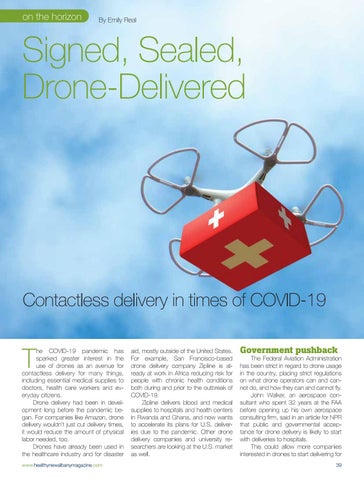on the horizon
By Emily Real
Signed, Sealed, Drone-Delivered
Contactless delivery in times of COVID-19
T
he COVID-19 pandemic has sparked greater interest in the use of drones as an avenue for contactless delivery for many things, including essential medical supplies to doctors, health care workers and everyday citizens. Drone delivery had been in development long before the pandemic began. For companies like Amazon, drone delivery wouldn’t just cut delivery times, it would reduce the amount of physical labor needed, too. Drones have already been used in the healthcare industry and for disaster
www.healthynewalbanymagazine.com
aid, mostly outside of the United States. For example, San Francisco-based drone delivery company Zipline is already at work in Africa reducing risk for people with chronic health conditions both during and prior to the outbreak of COVID-19. Zipline delivers blood and medical supplies to hospitals and health centers in Rwanda and Ghana, and now wants to accelerate its plans for U.S. deliveries due to the pandemic. Other drone delivery companies and university researchers are looking at the U.S. market as well.
Government pushback
The Federal Aviation Administration has been strict in regard to drone usage in the country, placing strict regulations on what drone operators can and cannot do, and how they can and cannot fly. John Walker, an aerospace consultant who spent 32 years at the FAA before opening up his own aerospace consulting firm, said in an article for NPR that public and governmental acceptance for drone delivery is likely to start with deliveries to hospitals. This could allow more companies interested in drones to start delivering for 39













